
The Muskox(Ovibos moschatus) is a hoofed mammal that is found in arctic regions. Muskoxen are classified in the mammalian order Artiodactyla, and the Bovidae family. Muskoxen live in herds(groups of hoofed mammals) of up to 50 individuals. When Muskoxen are threatened by predators the adults of the herd will encircle the young to protect them.
Physical Characteristics
Muskoxen are thickset Caprines with big heads, short necks, and short, chunky legs. Their coat is made up of durable guard hair with a soft, thick layer underneath called qiviut, which they shed in the summer. Both males and females have horns that bend downward over the head and then turn up at the tip,
| Length | 1.35-2.6 m(4’5”-8’6”) |
| Shoulder Height | 1-1.5 m(3’3”-4’11”) |
| Tail Length | 9-10 cm(3.5-4 inches) |
| Weight | Usually 160-410 kg(353-904 pounds) |
Distribution and Habitat
Muskoxen inhabit tundra, and can be found in Canada and Greenland, and have been reintroduced to Alaska, Norway, Russia and Sweden.
Breeding
The Muskox’s breeding season is from August to September. Males fight for mating rights by banging their horns and their heads together. The male will mate with as many females as he can win access to. After a gestation period of 8 to 9 months the female will give birth to typically one calf, although on rare occasions she may give birth to twins. The female’s fat may be used to support lactation for calves that are born before the vegetation she eats is uncovered by the melting snow. The calf will nurse for 15 to 18 months.
Diet
The Muskox eats sedges, forbs, grasses, lichens, willows, aquatic vegetation, and moss.
Fun Facts
- . An estimated 80% of the world’s muskoxen are in Canada.
- Male Muskoxen have a thick horn growth on their foreheads that is called a ”boss”.
- The Inupiaq word for muskox is “Oomingmak”, meaning “the bearded one”, refers to their long outer hair.
- The Muskox’s Inuktitut name “umingmak” translates to “the bearded one”.
- Muskoxen can live up to 22 years.
- Male Muskoxen have a strong musky odor hence the name.
- The Muskox’s scientific name, Ovibos moschatus means “musky sheep-ox” in Latin.
- Muskoxen can reach speeds up to 60km/h(37 mph).
- Muskox is also spelled Musk Ox. The pluralized form is muskoxen or musk oxen, or simply Musk Ox or Muskox.
